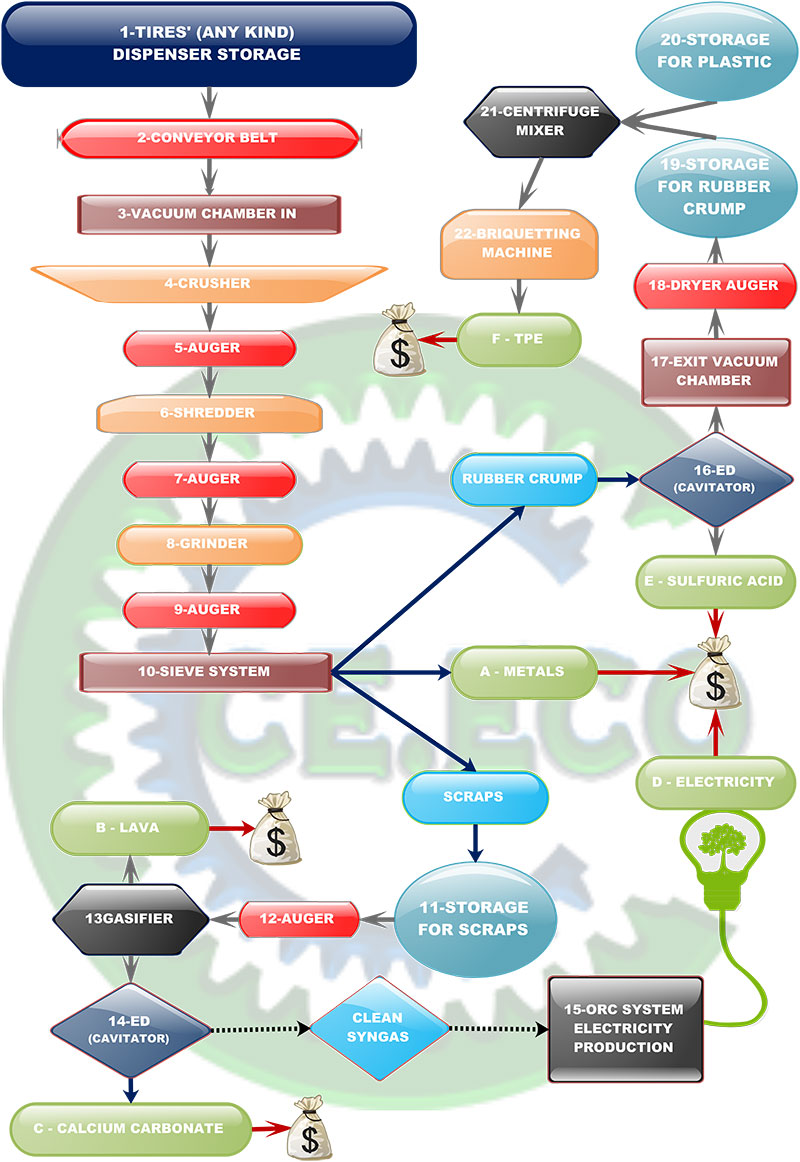The system we propose is highly automated, zero emissions and capable of produce the energy necessary for its operation.
Obviously, the tires must first be deprived of the metal rim.
Once stacked in a specific container (1), a conveyor belt (2) system will guide them, one by one, towards the entrance (3) to the process that will take place in a airproof environment kept in negative pressure: which will prevents that the air come into contact with the treatment could leak outside before being in turn treated and purified.
Unlike the other treatment systems, ours, as already mentioned, takes place in an environment isolated from the outside, also using special augers to transport the material from one section to another, but always at room temperature.
Once the tires are dropped onto the conveyor belt, they are subjected to a shredding cycle (4), a granulation cycle (6), a grinding cycle (8) and a rigorous screening with magnetic and volumetric separation (10).
With the shredding, coarse pieces of about 5 centimeters in length are obtained.
With the granulation and the subsequent grinding the pieces reach such dimensions as to allow a complete separation of the pneumatics’ components.
After these treatments, once the metal part and the textile fibers have been removed, the remaining size will be reduced to uniform granulometry and therefore easily separable: 0 ÷ 0.7 mm for the crumb rubber and 1 ÷ 4 mm for all the remaining fraction to be used for energy production.
Since, as already mentioned, the whole process described above will take place in airproof environment kept in negative pressure, the air coming into contact with the dust and the other substances contained in the tires will not be dispersed into the surrounding environment but, through bubbling, will be completely treated with our cavitation system (14) that will allow the flotation and sedimentation of any impurities present.
The treated water leaving the cavitator will be filtered by means of special self-cleaning graphene filters, of our design, that will retain all the precipitated or floated components during their permanence in the cavitator.
Then it will end up in external tanks that will also be used by the fire-fighting system, in full compliance with current safety regulations.
The pulverized material will be washed through a second cavitation system (16) always designed by us and, also through activation with ozone and UV C rays, a complete desulphurization of the powder itself will take place.
The concentrated processing liquid will consist solely of sulfuric acid (E) and can be sold, for example, to companies that carry out galvanizing.
The resulting water will be reused for further processes while the sulfuric acid will represent about 5% of the total weight of the treated tires.
The crumb, mainly composed of rubber, represents about 45% to 65% of the treated material, from 40% to 60% after washing. The precise amount depends on the starting characteristics of the tire.
This can be easily mixed with recycled plastics (21) such as PET or PVC in order to obtain a Thermoplastic Elastomer (TPE) (F) in the desired compounds, characteristics and shapes.
Once the desired mixture has been identified, the new product can either be left in a powder or be formed in the form of balls or bars (22) using special granulators for TPE.
The metal removed during the process represents about 5% to 15% of the treated material, also in this case it depends on the characteristics of the tire, and will be transferred to the foundries for full and total recovery.
The remaining material, which include textile fibers and may vary from 20% to 50%, will instead be fed into a gasifier (13) that will produce zero-emission electricity (D) (module for accessory calcium carbonate) directly on site and then can supply it for self-consumption of the rest of the plant.
The carbon dioxide produced during gasification will not be released into the atmosphere but will be transformed into calcium carbonate (C), which is not harmful to the environment and can be resold, always inside the first cavitator (14).
Since the gasifier is equipped with a plasma electrode in the tail, only a small quantity of lava material (B) will come out, which can be molded into objects or used for ballast.
The entire system is remote controlled and use a PLC under Industry 4.0 standard.
We believe it is plausible that a correct production should approach the following values:
|
crumb rubber |
|
55% |
|
sulfuric acid |
|
5% |
|
metal |
|
10% |
|
material to be used for energy recovery |
|
30% |
the percentages of materials that normally make up a tire are:
|
Rubber (natural and synthetic) |
|
41% |
|
Fillers (carbon black, silicon, carbon, gypsum, etc.) |
|
30% |
|
Reinforcement materials (steel, polyester, rayon, nylon) |
|
15% |
|
Plasticizers (oils and resins) |
|
6% |
|
Chemicals for vulcanization (sulfur, zinc oxide, etc.) |
|
6% |
|
Anti-aging agents and other chemicals |
|
2% |











